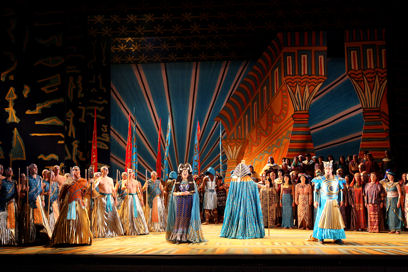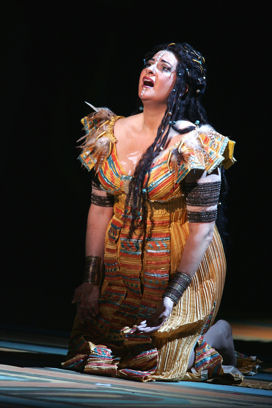Other Links
<Editorial Board
- Editor - Bill Kenny
- London Editor-Melanie Eskenazi
- Founder - Len Mullenger
Google Site Search
SEEN
AND HEARD OPERA REVIEW
Verdi, Aida: English
National Opera at the
London
Coliseum. Soloists, chorus and orchestra of English National Opera
cond. Edward Gardner. 10.11 2007 (ME)
Trekkies hungry for their next Convention should rush along to the
Coliseum, where with only a little ocular adjustment they will be
able to imagine themselves in one of the more outlandish galaxies,
thanks to the plethora of otherworldly costume and make-up on
display. The fact that some of the cast often seem to be singing
in Klingon will make them feel even more at home. Of course, there
is much else to draw one to the ENO for this production, and it
certainly fulfils the all-important requirement of having all the
trappings of a ‘big hit show,’ which ENO needs right now.
The vocal stars of the evening are the two bass-baritone kings,
Gwynne Howell as the Pharaoh and Iain Paterson as Amonasro: Howell
was a model of commanding stature as well as perfect diction, and
I have seldom heard Aida’s father so convincingly portrayed as in

(L-R) Jane Dutton as
Amneris and John Hudson as Radames
You can’t really update a classic piece of inherently daft ‘Grand
Opera’ such as Aida, so it’s fortunately spared the AK47
treatment meted out to everything else from Giuilo Cesare
to Fidelio: however, the idea with Opera Seria is that even
though the singers barely move and can’t act for toffee it doesn’t
matter because they are pouring out those liquid streams of sound,
occasionally spiked with the ping of a B flat or a high C – there
have been only two freaks (I use that term in its best sense) who
could / can act convincingly whilst hurling out spot-on musical
climaxes, those being Callas and Juan Diego Flórez. None of ENO’s
current crop are pourers of liquid streams, and with two notable
exceptions they are not actors either, so one has to ask why it
was felt necessary to stage a new production of Aida here
for the first time since 1979? One can only assume that the lure
of a co-production designed by Zandra Rhodes was too much to
resist, but really – give 4C a few big pots of turquoise and
tangerine paint, assign one or two of the more reliable girls to
gold glitter duty and let that new art teacher loose with her
glossy brochure from the King Tut exhibition, and there you have
it.

Claire Rutter as Aida
The chorus sang brilliantly, the orchestra played finely for
Edward Gardner, and the production is bright to the point of
garishness, and chimes in nicely with the ‘Egyptian’ theme which
London will soon experience with the Tutankhamen exhibition.
However, it is soulless in the extreme: when Radames enters his
tomb he is lowered via a steel cage from what appears to be the
only opening, making nonsense of how Aida is supposed to have
slipped in there. As they sang’ O, terra, addio’ I’m afraid I was
entirely unmoved – but I have to be fair and remark that the lady
next to me was dabbing at her eyes during the entire scene. A
palpable hit, obviously, with her, and sure to delight those who
love a traditional staging enlivened with plenty of colour.
Melanie Eskenazi
Pictures © Tristram Kenton/English National Opera
